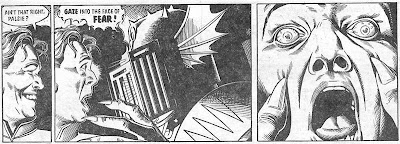Alan Moore considers his and artist Brian Bolland's Batman: The Killing Joke to be one of his "inferior" works; I'm not sure why, because it pretty much grips and shocks from start to finish.
It's essentially the Joker's origin story, and explains the unique connection between the Joker and the Batman; that "one bad night" can tip your life one way or the other. It also explicitly asks questions about the nature of "madness" - is a person who dons a cape and cowl and prowls the streets by night beating up criminals to avenge his dead parents any less "mad" than a psychotic "clown" who kills people because he finds it funny?
Anyway, the stand-out sequence in the book involves the Joker's terrifying kidnapping of Commissioner James Gordon and the shooting of his librarian daughter, Barbara (Batgirl):



Moore's/Joker's black humour shines through: "Mind you, I can't say much for this volume's condition. I mean, there's a hole in the jacket and the spine appears to be damaged."
After this sequence, the Batman visits Barbara in hospital. There's a note of real terror here in Barbara's voice:

Later, the Joker torments Gordon with images of his naked, crippled daughter:
 This was shocking then (as it is now) because there was rarely a sense of consequences of the Joker's insanity; he would kill people, be captured & sent to prison, escape then the sequence would begin again. The psychological (and physical) effects of his madness were never considered. It's to DC's credit (and a testament to the power of Moore's writing and Bolland's images) that, as of writing this, Barbara Gordon remains in a wheelchair 20-odd years after this story. Every time I see her in her wheelchair, I think of The Killing Joke.
This was shocking then (as it is now) because there was rarely a sense of consequences of the Joker's insanity; he would kill people, be captured & sent to prison, escape then the sequence would begin again. The psychological (and physical) effects of his madness were never considered. It's to DC's credit (and a testament to the power of Moore's writing and Bolland's images) that, as of writing this, Barbara Gordon remains in a wheelchair 20-odd years after this story. Every time I see her in her wheelchair, I think of The Killing Joke.























